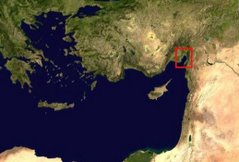
Juan was on fire today; he kept finding impressive fragments, so we named the site "Juan Höyük." Here he is beside the cut, holding up the handle to a vessel:

Juan also came close to literally being on fire - the villagers later took us to a site where natural gas is emitted from the ground, fueling a constant flame. The rock itself seems to burn:

We do not know what the lifespan of such phenomena is, but if this were burning already in ancient times, this site may have been a religous sanctuary or a ritual area, since the ancients were likely to have interpreted this fire as a divine manifestation. At least some ancient activity is attested here, from the ceramic material we collected, most of which is apparently Hellenistic.
Another site worthy of mention was an area containing Roman period graves. Apparently this site has previously been excavated, but it has since been looted and severely damaged:

Very little material would have been visible on the surface, but the looted pits still contained some remains. Here is a fragment of one of the ceramic coffins:

The bones of one of the occupants of this tomb are now exposed to the air:

The last site the villagers showed us was a natural spring, which they claimed is able to cure skin diseases. I, unfortunately lacking skin diseases, was unable to test this claim.



1 comment:
My Story I love your blog!
Post a Comment